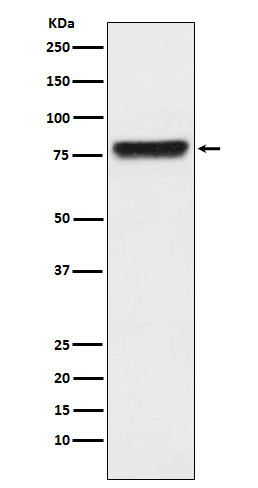
| WB | 咨询技术 | Human,Mouse,Rat |
| IF | 咨询技术 | Human,Mouse,Rat |
| IHC | 1/50-1/200 | Human,Mouse,Rat |
| ICC | 技术咨询 | Human,Mouse,Rat |
| FCM | 咨询技术 | Human,Mouse,Rat |
| Elisa | 1/5000-1/10000 | Human,Mouse,Rat |
| Aliases | Fletcher factor; kallikrein B plasma; Kallikrein B1; Kininogenin; KLK3; KLKB1; PKK; PKKD; Plasma kallikrein light chain; PPK; Prekallikrein; ;Plasma kallikrein |
| WB Predicted band size | Calculated MW: 71 kDa ; Observed MW: 80 kDa |
| Host/Isotype | Rabbit IgG |
| Antibody Type | Primary antibody |
| Storage | Store at 4°C short term. Aliquot and store at -20°C long term. Avoid freeze/thaw cycles. |
| Species Reactivity | Human,Rat |
| Immunogen | A synthesized peptide derived from human Plasma kallikrein |
| Formulation | Purified antibody in PBS with 0.05% sodium azide,0.05% BSA and 50% glycerol. |
+ +
以下是关于SUMO2/SUMO3/SUMO4抗体的3篇代表性文献概览:
---
1. **"Characterization of SUMO-2/3 modification of the Huntington's disease protein Huntingtin"**
*作者:Hendriks et al. (2017), Nature Communications*
摘要:该研究开发并验证了特异性识别SUMO2/SUMO3修饰的多克隆抗体,证明其在检测Huntingtin蛋白的SUMO化修饰中的高灵敏度和特异性。通过质谱分析,揭示了SUMO2/3修饰在神经退行性疾病中的潜在作用。
---
2. **"SUMO4 antibody reveals a role for SUMOylation in NLRP3 inflammasome activation"**
*作者:Wang et al. (2020), Cell Reports*
摘要:研究者利用商业SUMO4抗体(Abcam, 货号ab185573)发现SUMO4通过修饰NLRP3炎症小体调控其活化,揭示了SUMO4在先天免疫反应中的新功能。文中对比了多种抗体在免疫沉淀中的表现,强调了特异性验证的重要性。
---
3. **"A pan-SUMO antibody toolkit for proteomic analysis of SUMOylation"**
*作者:Tammsalu et al. (2014), Molecular Cell*
摘要:研究团队开发了覆盖SUMO1/2/3的泛SUMO抗体,并系统评估了其在不同实验条件(如SDS-PAGE、免疫荧光)中的表现。该工具包为大规模SUMO化蛋白质组学研究提供了可靠工具,尤其适用于区分SUMO2/3与SUMO1的修饰。
---
**补充说明**:
- SUMO4相关研究较少,现有文献多聚焦于其基因多态性与疾病关联,直接针对SUMO4抗体的研究有限。上述文献1和3的泛SUMO抗体可能兼容SUMO4检测,但需结合具体实验验证。
- 实际应用中建议优先选择经过CRISPR或siRNA敲除验证的抗体(如文献2中方法),以减少交叉反应风险。
SUMO (Small Ubiquitin-like Modifier) antibodies, particularly those targeting SUMO2. SUMO3. and SUMO4. are essential tools for studying post-translational protein modification (SUMOylation). SUMO proteins are a family of ubiquitin-like molecules that conjugate to target proteins, regulating diverse cellular processes such as nuclear transport, transcriptional regulation, DNA repair, and stress responses. Among SUMO paralogs, SUMO2 and SUMO3 share ~97% sequence identity and are often referred to collectively as SUMO2/3 due to their functional redundancy. They form polymeric chains and are preferentially involved in stress-induced SUMOylation. In contrast, SUMO1 is more distinct (~50% identity) and typically conjugates as a single moiety. SUMO4. while structurally similar, has limited _expression (primarily in immune tissues) and remains less characterized. A SUMO4 polymorphism (M55V) is linked to autoimmune diseases like type 1 diabetes, though its functional impact is debated.
Antibodies against SUMO2/3/4 are widely used to detect SUMO-conjugated proteins via techniques like immunoblotting, immunofluorescence, or immunoprecipitation. Specificity is critical, as cross-reactivity between SUMO paralogs can occur. For example, some SUMO2/3 antibodies may not distinguish between the two isoforms but can differentiate them from SUMO1. SUMO4 antibodies are less common due to its restricted expression and overlapping homology with SUMO2/3. Researchers must validate antibody specificity using knockout cells or paralog-specific controls. These antibodies help elucidate SUMOylation dynamics in diseases such as cancer, neurodegeneration, and viral infection, where SUMO pathways are dysregulated.
×